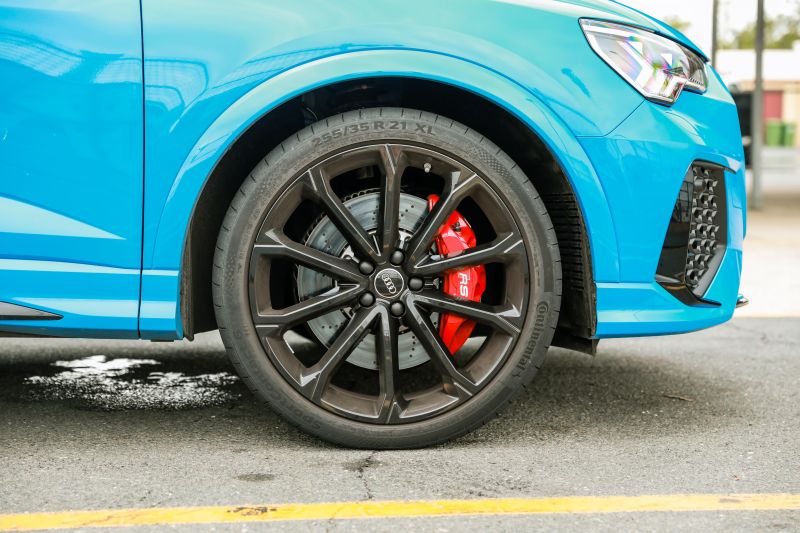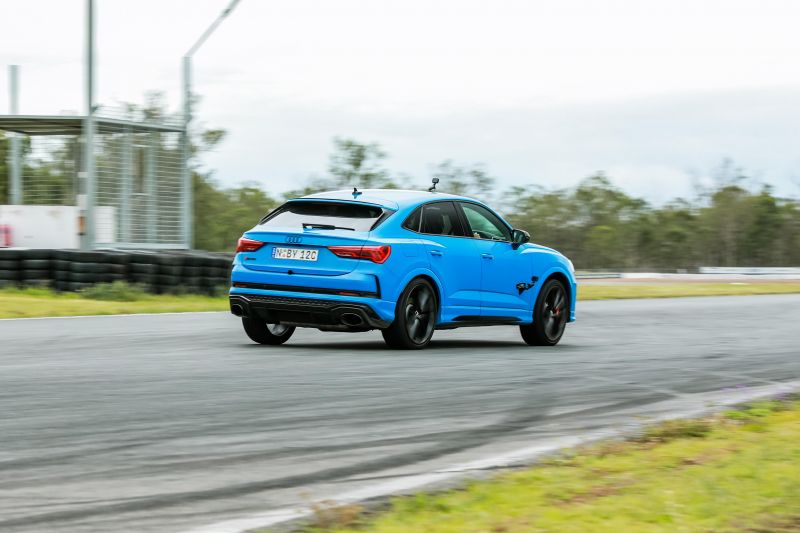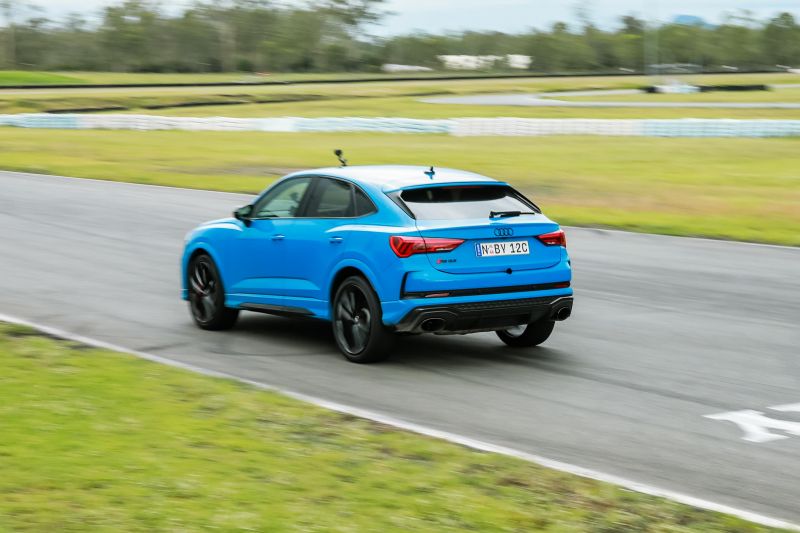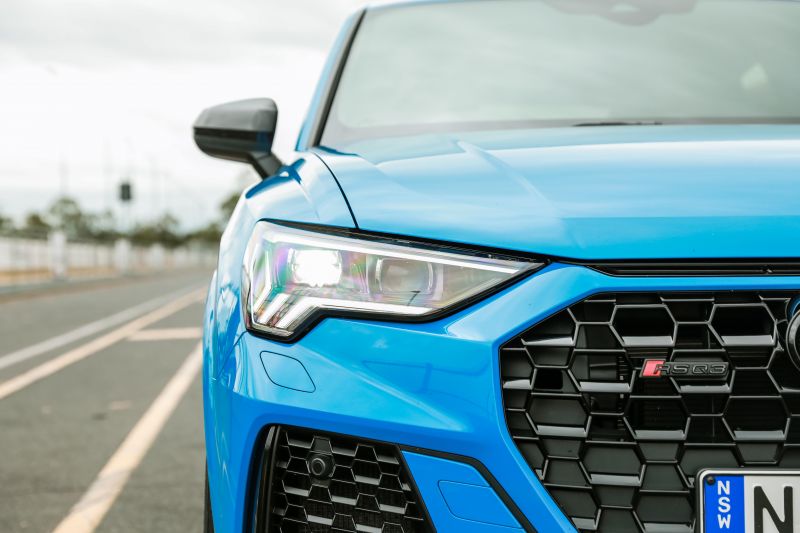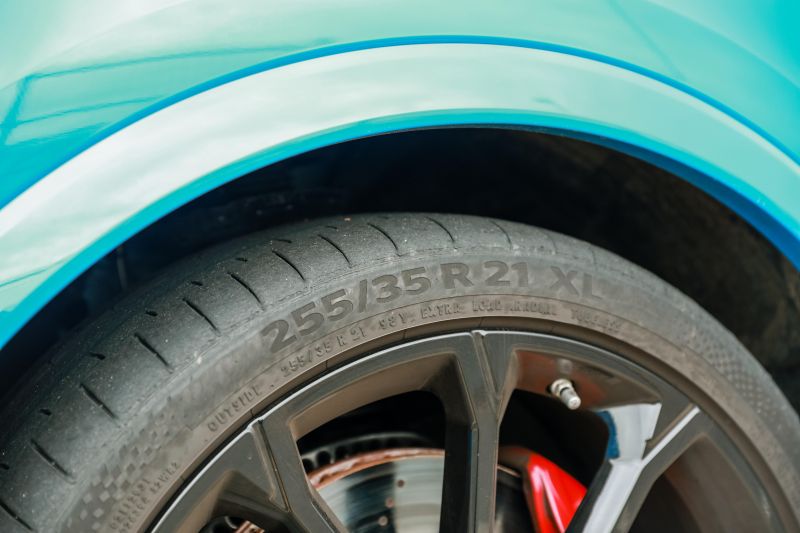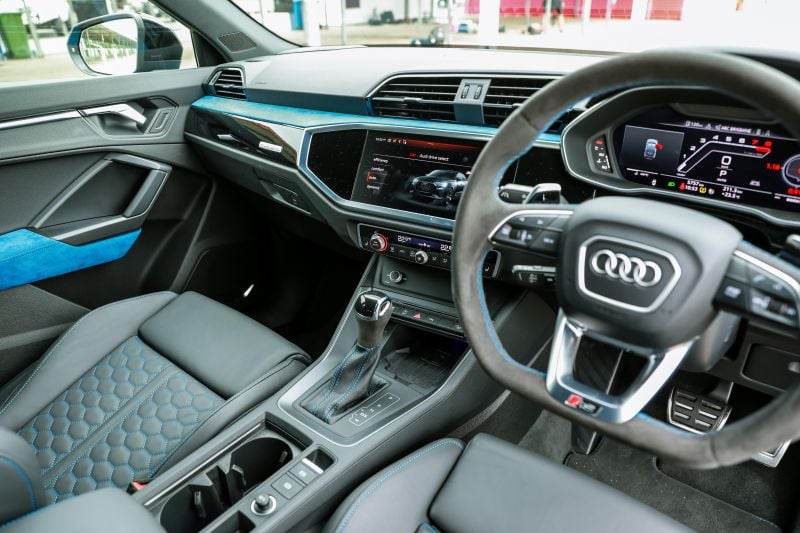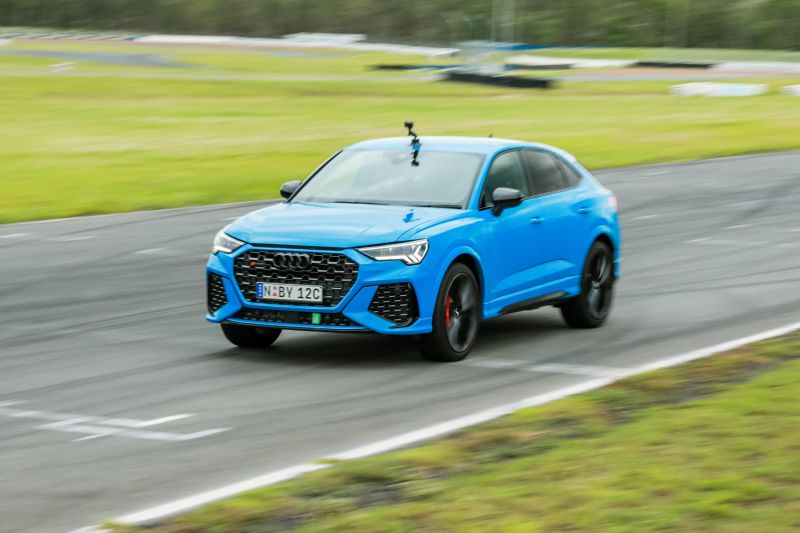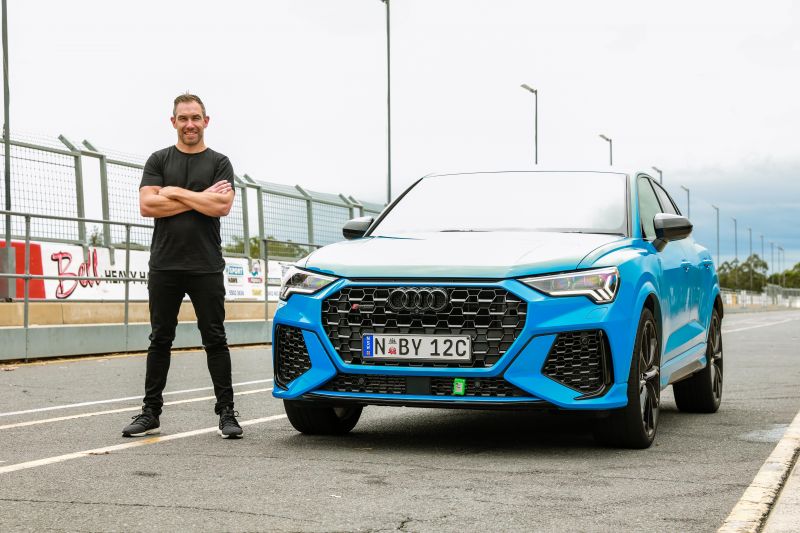Overall Track Performance
Well, finally we have an SUV on the leaderboard and an impressive looking one at that!
The Audi RSQ3 Sportback definitely looks the part, and when it comes to performance and track work it stepped up to the plate as well.
While the RSQ3 Sportback is a great package I think many people will enjoy, it just misses a few of the finer details to be absolutely exceptional on the track.
Engine
On paper the Audi RSQ3 Sportback’s engine ticks all the boxes.
A 2.5-litre turbocharged five-cylinder petrol with 294kW of power and 480Nm of torque. Oh, and it sounds amazing.
Now if you want something that is point-and-shoot, then it does that well, but I found it to have a little too much turbo lag on track and it was also very focused on the top-end of the rev range.
I really had to be in the right gear to get the response required, and as I will get to a little later, that wasn’t always that easy to achieve.
Braking
The brakes in terms of stopping performance worked well, but my interaction with the pedal was far from ideal.
I know a lot of this comes back to the safety systems designed into many modern cars, yet the level of interference and variance of pedal feel is really frustrating when trying to extract the most from a car on track.
As a rally driver I am maybe even more sensitive to this than most, my pedals are almost as much a tool in determining the direction the car is pointing and to what degree as the steering wheel itself.
I know 99 per cent of people who drive this car won’t be affected by this, but if you want to make a driver’s car, you need consistency with the brake pedal.
I really don’t like the feeling when you just want a small deceleration and the car over responds and if this was sorted my experience would have been completely different.
Chassis
The chassis is an interesting one, as I actually think it is more the brakes and differentials that really holds this car back on the track, but it’s hard to disconnect these feelings from what the car is actually capable of.
Especially initially, when the chassis had a real bias towards understeer and lacked lateral grip, I was really worried. But once I figured out the best suspension setting, which allowed a bit more movement, then I could get the chassis to work with me.
It needed that little bit more movement to gain some grip and allow the car to rotate, rather than pretending it was on rails.
When you allow for that movement, it still feels quite pointy and sharp in the front end and offers a lot of confidence with quick changes of direction, which is impressive for what is still a reasonably heavy car at 1815kg.
The Audi RSQ3 Sportback fundamentally has a good chassis and they have done a good job of making an SUV feel exciting and balanced, which makes it easy and enjoyable to hustle along.
Transmission and Differentials
You would think a seven-speed dual-clutch transmission would be perfect for the RSQ3 Sportback in a track setting, yet my frustration with the inability to downshift on command really dulled my experience at the limit.
Even when I deliberately waited for the revs to drop further than I felt necessary, it would occasionally ignore my suggestion that we should be in a lower gear in preparation for the next move. I even had one instance when it took three attempts to get one downshift.
Upshifts, however, were excellent – fast and smooth with no issues.
The differential balance had a tendency towards a front-wheel drive feeling, this is no real surprise with the Haldex system in use here. It could never transfer enough torque to the rear wheels to overcome the grip we had.
To be fair it wasn’t that it had massive push, just that you couldn’t influence the attitude of the car with the throttle. It was just very neutral.
Actual traction was excellent, and I had no issues with that on the track. It was more that I wanted the ability to have another tool in my arsenal when it came to manipulating the balance of the car and the differentials were not there for that.
Suspension
The Audi RSQ3 Sportback gets standard sports suspension with adaptive dampers which were very well sorted, but it was interesting that I did my best times in the middle setting (Balanced) over the firmest setting (Dynamic).
I decided to try that because the lateral grip didn’t feel great on the first outings and actually managed a time of half-a-second faster just by changing to the softer setting, which is still far from soft.
It really goes to show that just by making something stiffer, it doesn’t always make it corner faster. As I have mentioned several times previously, it’s how you and the car control the weight and movement that aid cornering most.
If there is no give in the suspension, then it is all down to the tyre to control the energy, which via the massive 21-inch wheels and Continental rubber is almost impossible.
The RS suspension is a real step up on the S variants, offering a lot damper control and support, without a crazy level of harshness.
Steering
As with most Audis the steering in the RSQ3 Sportback was ok and offered decent feedback, but was a little bit to light for my liking even in its sportiest setting.
Wheels and Tyres
The Audi RSQ3 Sportback rides on massive 21-inch 255/35 Continental SportContact 6 tyres, which worked pretty well but gave me the feeling that I was a just on top of the road rather than biting into it.
This of course can be attributed in part to the higher centre of gravity of the RSQ3 compared to an RS3, but also you get the feeling when it came to deciding the size of the wheels, they were more focused on looks rather than performance.
Driver Aids (Electronics)
I ran with all the driver aids off as you might have guessed, and I had the engine and drive systems set to dynamic.
The biggest talking point was that the suspension worked better in Balanced rather than Dynamic on our test track.
Cockpit (Ergonomics)
I really liked the RS steering wheel, the size, shape and texture with the Alcantara trim, all great for track use.
However, I do have a habit of brushing some of the buttons on Audi steering wheels with the inside of my palm and changing radio stations while in full attack, which is a bit distracting, but a self-induced issue.
I would have liked slightly deeper seats, especially in an SUV, as I already felt like I was sitting a little high and the seat didn’t help with this feeling. Lateral support turned out to be ok, even though you don’t feel fully embraced by the seat.
Lap Time
With the Audi RSQ3 Sportback I had to make an exception to our normal sequence on the track, after trying twice with everything in full attack mode, I couldn’t break the 60-second barrier, with a best of 60.5 seconds and an average closer to 61.0 seconds.
I knew this car had more in it and surely couldn’t be slower the Audi S3. Everything on paper said it should be faster, but it just wouldn’t hook up on the track.
Finally, I decided to try softening the suspension and immediately the car responded, bang straight to 59.93 seconds. That’s more like it! Any car running a sub-60-second lap at Queensland Raceway is really moving, let alone an SUV.
There are some really good fundamentals and with some slight changes to the brake feel and differentials, it would be epic.
Did I love this car on the track? Personally, no. But is it quick, exciting and looks the part? Absolutely!
Atko’s 3:
- Be mindful it will react like a front-wheel drive car on power
- Being in the correct gear is important to get the most out of the engine
- Be patient with downshifts, the more you rush it the worse it is
Click the images for the full gallery





